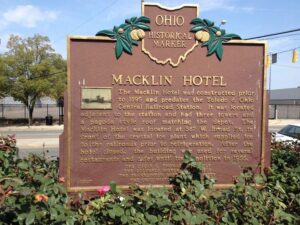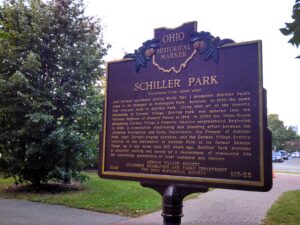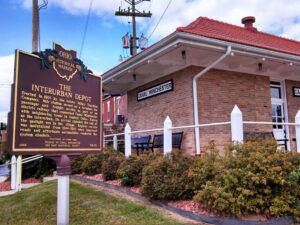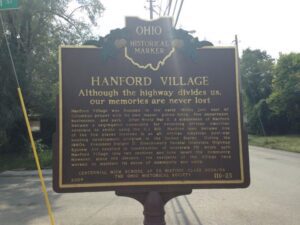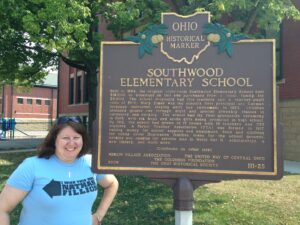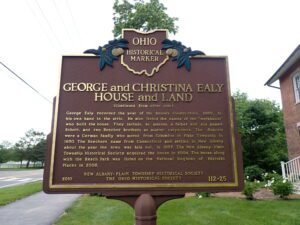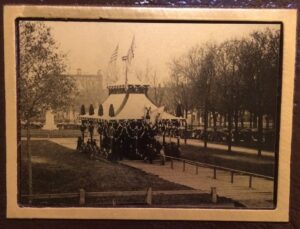, OH
The only remaining Columbus railroad station, The Toledo & Ohio Central (T&OC) Railroad Station was constructed in 1895 and was the departure point for William McKinley when he left for Washington D.C to be sworn in as president. Designed by noted Columbus architects Joseph Warren Yost & Frank L. Packard, the pagoda style roof and tower have become Columbus icons. By 1900, the T&OC was purchased by the rival Hocking Valley Railroad and in 1911 the tracks were elevated above Broad Street. Later the New York Central Railroad gained control and used the station until 1930 when passenger service was transferred to Union Station in Columbus. Restored after the 1913 Flood and major fires in 1910 and 1975, the station was headquarters for the Central Ohio Volunteers of American from 1930 to 2003. The building was placed on the National Register of Historic Places in 1973.
, OH
Long a gathering place for residents of Columbus, this area, which became known as Schiller Park, hosted German songfests, Fourth of July festivities, the 1864 and 1865 Ohio State Fairs, and the 1871 peace celebration commemorating the end of the Franco-Prussian War. In 1867, the City of Columbus purchased 23 acres of this area, then known as Stewart’s Grove, for $15,000 and named it City Park. On July 4, 1891, before a crowd of 50,000, the German-American community dedicated the 25-foot tall, 2,640 pound statue of German poet Friedrich von Schiller that had been cast in Munich, Germany and given as a gift to the City of Columbus. In 1905, the Park’s name was changed to Schiller Park. (Continued on other side)
, OH
Erected in 1905 by the Scioto Valley Traction Company, this station served as a terminal for passenger and freight service as part of an electric railway that connected Canal Winchester with neighboring towns in central Ohio. Known as the interurban, its arrival signaled the end of the gaslight era in the village. Regular service was maintained from 1904-1930 when improved roads and affordable automobiles rendered the system obsolete. [continued on other side]
, OH
Hanford Village was founded in the early 1900s just east of Columbus proper with its own mayor, police force, fire department, businesses, and park. After World War II, a subdivision of Hanford became a segregated community for returning African American veterans to settle using the G.I. Bill. Hanford then became one of the few places involved in an all African American post-war housing development program in the United States. During the 1960s, President Dwight D. Eisenhower’s Federal Interstate Highway System Act resulted in construction of Interstate 70 which split Hanford Village into two sections and tore apart the community. However, since the division, the residents of the village have worked to maintain its sense of community and unity.
, OH
Built in 1894, the original eight-room Southwood Elementary School cost $16,000 to construct on this site purchased from a local family for $3,000. The school originally had five teachers and a teacher-pupil ratio of 50-1. Mary Esper was the school’s first principal and German language instructor, staying until her retirement in 1923. Children attended grades one through eight and special biweekly classes in carpentry and cooking. The school had its first graduation ceremony in 1896, with six boys and seven girls being promoted to high school. By 1912, the school had grown to 17 rooms with 16 teachers and 735 students. A Parent Teacher Association (PTA) was formed in 1917, raising money for school supplies and equipment, food and clothing for needy Great Depression families, trees for the school grounds, cookies and candies for service men in World War II, scholarships, a new library, and much more. [continued on other side]
, OH
The George and Christina Ealy House is a testament to the prosperity of one of this area’s early residents and the skills of mid-nineteenth-century craftsmen. In 1830, members of the Ealy family moved from Pennsylvania to a 73-acre parcel where the house and six-acre Resch Park surrounding it are located. The Ealys were representative of a second wave of pioneers who settled Plain Township after 1812. The Ealys cleared land for farming and operated a sawmill on Rose Run. George prospered and in 1860 built this fine brick house. Architecturally, the house exhibits the transition between Greek Revival and Italianate styles. Its layout reflects the former; its proportions and decorative detail, the latter. (Continued on other side)
, OH
Philip T. Snowden, owner of a fancy dry goods and millinery, built the Italianate-style residence at 530 East Town Street in 1852. The house was part of the fashionable University Place addition on the east side of the city. From 1862-1864 Ohio’s governor, David Tod, lived here. Columbus philanthropist David S. Gray purchased the house in 1870 and his family held it until 1922. One of the city’s premier architects, George Bellows, Sr. rebuilt the house in 1872. From 1923 to 1940, the house was the headquarters of the Columbus Women’s Club. In 1951, the Kappa Kappa Gamma fraternity for women acquired the house as its national headquarters. (Continued on other side)
, OH
Abraham Lincoln visted Cleveland twice; once in life and the other in death. The first visit was on February 15-16, 1861, while in route to his presidential inauguration. The second, more solem visit was on April 28, 1865. Cleveland was one of twelve citiels to host a scheduled public viewing of the assassinated president’s remains. In addition to local officials, Lincoln’s cortege included a military escort of then current and former Union officers who were veterans of the Civil War. These officers would form the early membership of the organization known as the Military Order of the Loyal Legion of the United States. (continued on other side)


